Pat Dolan’s installation Stalking the Sacred * is not a conventional exhibition of works–in-a-row. In fact, Pat deliberately uses the word ‘Installation’ to make the distinction that while the show has many layers, it designed to function as a single work of art.
Pat has been exploring such thematic installations as an art form since the 70s, beginning with “Trail Mix,” a meditative walking trail through the desert at Rancho Linda Vista created with her husband Charles Littler.
For those of us who have known Pat over many years, it is crystal clear that exploring the space of the sacred is her core creative process. In this new installation Stalking the Sacred, she reflects upon her life long exploration of shamanic practice including formal studies in California (1993-95), several retreats to the rain-forests of Ecuador, Peru and the Galapagos islands, and visits to many sacred sites in Ireland. When I asked Pat what she means by the word ‘shamanic’ she replied that it is simply connecting our inner spiritual nature to the larger flow of ordinary life, especially in its capacity for healing.
Through her training and skills over 20 years, Pat has served many friends by creating ceremonies for significant life events like weddings and funerals. In her capacity as a teacher at The Drawing Studio, she has had a profound effect on students, not only by providing them with a solid foundation in the formal skills of art-making but also in relating art practice to the inner life, with special attention to the way art-making can help us navigate the processes of aging and change.
To fully participate in Stalking the Sacred I suggest viewers bring their own feelings and thoughts about what we consider sacred, and enter into a kind of conversation with the installation. While I don’t believe that people come to art shows to seek some ultimate spiritual ‘truth’, I do think there is a seeking element at work in looking at art. Because ‘works of art’ are not just ‘things’ to look at; they are often called ‘great’ just because they give us the physical and emotional access to the quality of our own lives in a way that abstract ideas cannot.
The subjects Pat describes in her work have direct meaning to her core spiritual life that includes nature and all sentient beings. Some works focus upon animals that have a personal relevance to her own journey (Figures 1,2,3); others emit an energy that flows to and from all forms of life itself (Figure 4).
For me, this layered physical energy permeates all her work, and indeed, beyond her personal narrative, is the actual ‘subject’ of her art: energy made visible, a record of kinetic mark-making that teems with life. It is a flow, as all artists know, that can only be earned through years of practice, in Pat’s case using the medium of drawing with charcoal and pastels, scrubbed and reintegrated over hours of layering until a vocabulary of energy simply emerges as a kind of personal language.
There is also the aura of a ‘journey’ throughout (Figures 5,6), a journey that has both inner and outer aspects, like a landscape that lives in our cellular and well as galactic dimensions. I think of it as a landscape that is always present on the periphery of life, often at moments of half waking or dreaming, sometimes accessible through meditation, but usually obscured by the overwhelming daily concerns of waking life.
In the world we live in, dominated by the industrial and communication technologies of our time, Pat quietly listens and embodies in her work and life echoes of the Sacred that still can be found intact in the shamanistic rituals of indigenous peoples. These rituals acknowledge and access the energetic connections among all that exist. Her work offers us some essential reminders of the inner resources still available to we human beings who must perforce live in a mechanistic culture.
If Pat’s Stalking the Sacred recalls us even in a small way to the landscape of our own inner life with that of our larger interconnected community, it has done its job as a relevant work of art for our time.

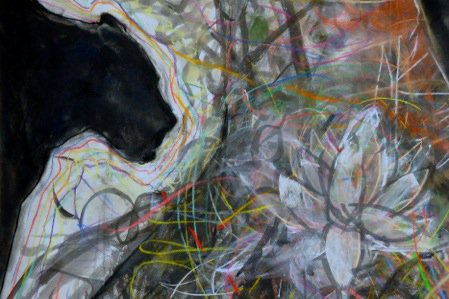
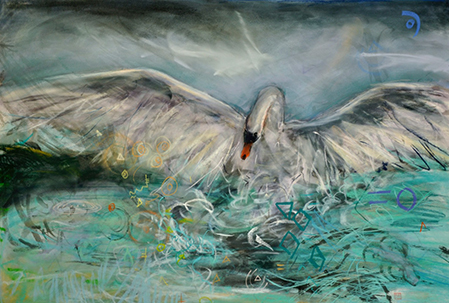
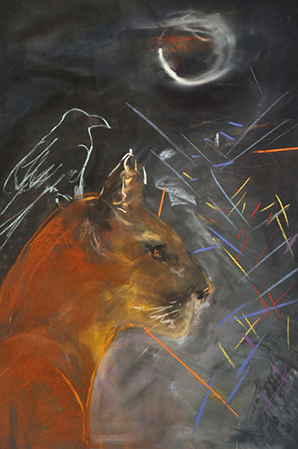
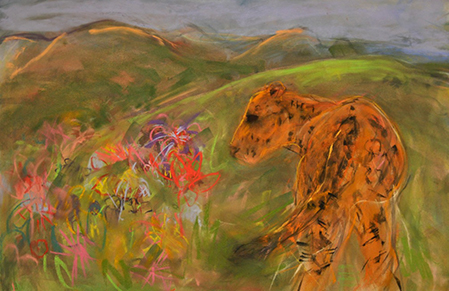
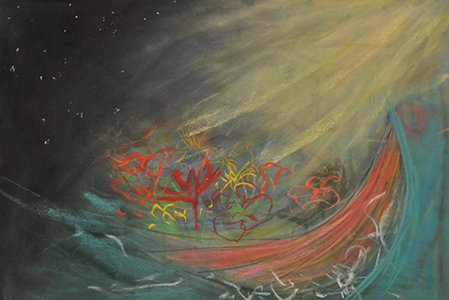




One Response to Stalking the Sacred: An installation of art by Pat Dolan